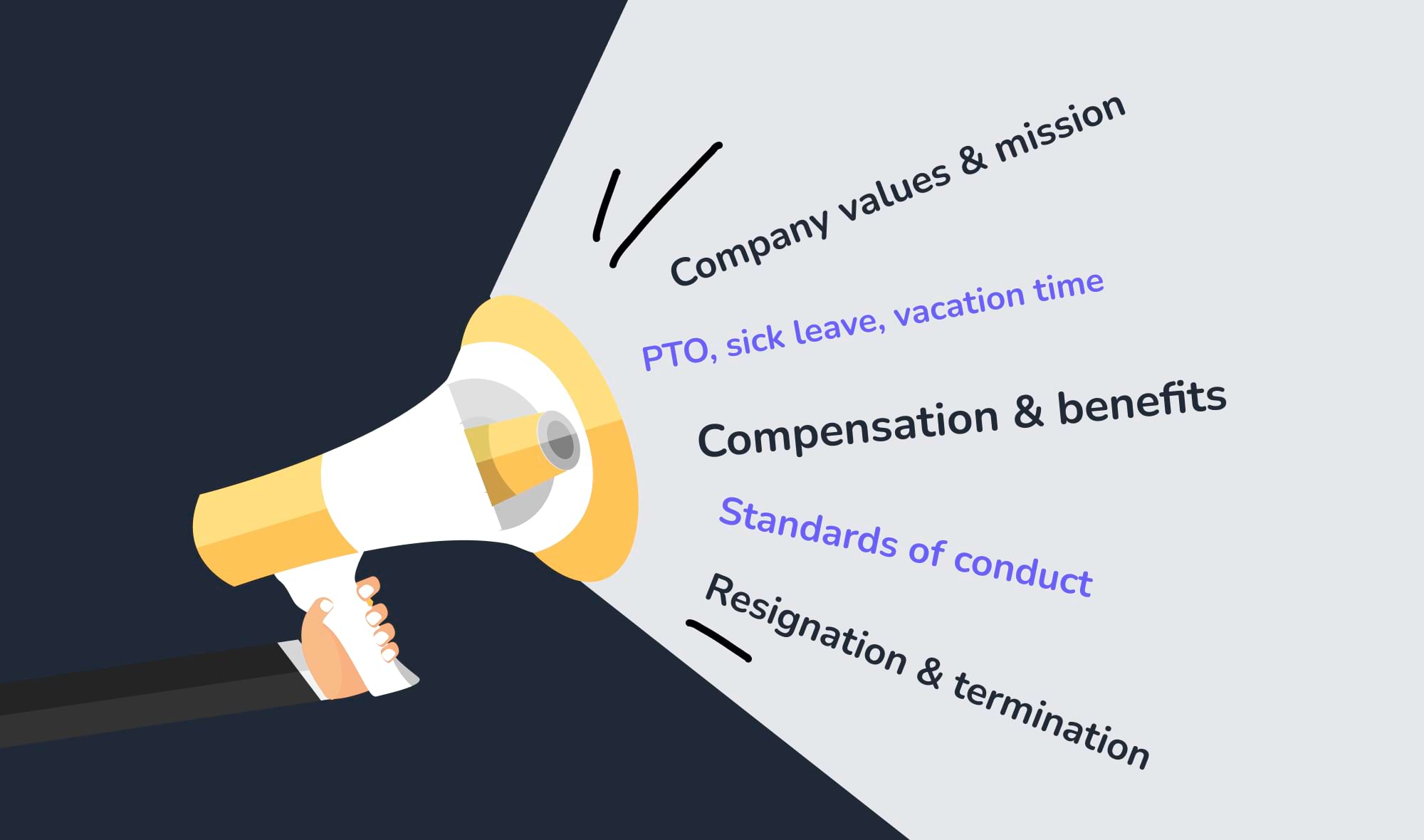How to create an employee handbook that aligns with your company's mission
By Remy Meraz • May 1, 2023

When new employees join your company, their first impression of your organization is critical. A smooth onboarding experience sets the tone for their long-term success and contributes to their overall job satisfaction. An essential part of this process is providing them with an employee handbook that outlines your company's mission, values, and policies. A well-crafted handbook helps new hires understand what is expected of them, how they can contribute to the organization, and what benefits and resources are available to them.
In this blog post, we'll provide practical tips and guidelines on how to create an employee handbook that aligns with your company's mission. We'll cover everything from defining your values to crafting clear and concise language and making your handbook accessible and up-to-date. So, whether you're creating an employee handbook from scratch or updating an existing one, we've got you covered.
Join our Newsletter
Transform your career with our personal growth insights. Get one valuable tip right in your inbox every Saturday morning.
Understand your company's mission

Simply put, a company mission is a statement that defines the organization's purpose, goals, and values. It outlines the reason the company exists, what it aims to achieve, and how it plans to get there. A strong mission statement should be concise, clear, and easy to understand.
Understanding your company's mission is crucial for a few reasons. First and foremost, it helps you and your team to have a clear sense of purpose and direction. Knowing what your company is striving to achieve and how it plans to get there can help you stay motivated and focused on your work.
Additionally, understanding your company's mission can help guide decision-making at all levels of the organization. When faced with a tough choice or challenge, you can refer back to the mission statement to ensure that your actions are aligned with the company's overall goals and values.
Finally, having a well-defined and well-communicated mission can also be attractive to your company's customers and potential employees. It can help build brand recognition and loyalty and can make your company more appealing to those who share your values and goals.
To write a strong company mission statement, keep these tips in mind:
Be concise:
Your mission statement should be short and to the point. Ideally, it should be no longer than a sentence or two.
Use simple language:
Avoid jargon or technical terms that might be difficult for employees or customers to understand.
Focus on the why:
Your mission statement should focus on the "why" of your business rather than the "what." For example, instead of saying "We make widgets," say "We help people solve their problems."
Be specific:
Your mission statement should be specific enough to be meaningful but broad enough to allow for flexibility as your company grows and evolves.
Involve stakeholders:
Consider involving employees, customers, and other business stakeholders in the mission statement writing process. This can help ensure buy-in and create a sense of shared ownership.
3 key components of an employee handbook

An employee handbook serves as a guidebook for employees on the policies, procedures, and culture of their organization. It typically covers topics such as company values, expectations, rules and regulations, and employee benefits. It is an important tool for creating consistency and fairness in the workplace, and for ensuring that all employees understand their rights and responsibilities.
A good employee handbook should contain three key components:
Standard policies and procedures
This section outlines the policies and procedures that employees are expected to follow. This may include rules on attendance, punctuality, dress code, and use of company equipment. It should also cover employment policies and procedures for requesting time off, reporting sick days, and other related matters.
Employee benefits and compensation policies

This portion should describe the employee benefits offered by the company, such as health insurance, retirement plans, vacation time, and sick leave. It should also cover the company's compensation policies, including information on pay rates, bonuses, and raises.
Guidelines for employee conduct and discipline
This section should lay out the expectations for employee conduct and behavior, as well as the consequences for violating these expectations. This may include policies on harassment, discrimination, workplace violence, and drug and alcohol use during working hours. It should also cover the disciplinary process, including the steps that will be taken in the event of a violation.
By including these three key components in an employee handbook, organizations and small businesses can ensure that their employees are informed and educated about the company from day one. This can help to create a more harmonious and productive workplace and can help to mitigate any potential legal risks that may arise from misunderstandings or disagreements.
Join our Newsletter
Transform your career with our personal growth insights. Get one valuable tip right in your inbox every Saturday morning.
What to include in a handbook for employees

Whether you are a first-time business owner looking to create an employee manual for new hires or an experience hiring manager or onboarding coordinator who would like to reinforce workplace policies, an employee handbook can accomplish all of that and more. However, it can be difficult for employers to capture all of the pertinent information in one place.
When drafting employee handbooks, be sure to include the following as it makes sense for your industry or business:
Company values and mission statement
The company mission statement is a concise statement that outlines the organization's purpose, goals, and values. It provides a clear sense of direction and helps to guide decision-making at all levels of the organization. Including the mission statement in the employee handbook can help new hires understand the organization's overall goals and how their role contributes to achieving those goals.
By including company values and the mission statement at the beginning of the employee handbook, new hires can gain a better understanding of the organization's culture and direction from the outset. This can help them connect with the organization and its goals more quickly and feel more engaged and invested in their work.
Additionally, setting the stage with the company culture can help new hires understand the context for the rest of the information provided in the employee handbook. It can help them see how the policies and procedures outlined in the handbook align with the organization's overall values and goals and can make it easier for them to understand why certain processes or rules are in place.
PTO, sick leave, vacation, and more

An employee handbook should provide clear and concise information about all types of leave available to employees, including Paid Time Off (PTO), sick leave, vacation time, and other types of leave. Begin by defining each type of leave and outlining the employment eligibility criteria for each. This may include minimum service requirements, work status, and other employment factors that determine an employee's eligibility for leave.
Outline how much leave employees accrue per pay period or per year, and specify any limits or caps on the amount of leave that can be accrued or used. Be sure to also detail the process for requesting and approving leave. This may include how far in advance employees need to request leave, who is responsible for approving leave requests, and any forms or documentation that need to be submitted.
Specify any rules around how leave can be used, such as whether it can be taken in half-day increments, and whether employees can carry over unused leave from one year to the next. Outline any pay or benefits the employer has that employees will receive during their leave, such as whether they will be paid their full salary, receive partial pay, or be eligible for benefits like health insurance.
Compensation and benefits information

An employee handbook should include comprehensive information about compensation and benefits to ensure that employees have a clear understanding of their pay and benefits structure. Some of the information that should be highlighted in this section of an employee handbook includes:
- Pay structure: A detailed explanation of how the employee will be paid, including the base salary, overtime pay, bonuses, commissions, and any other incentives.
- Performance review: The handbook should explain how performance reviews are conducted and how they impact salary increases or bonuses.
- Pay periods: Outline the pay periods date and how paychecks will be issued.
- Deductions: Information about deductions from an employee’s paycheck, including taxes, benefits, and any other deductions.
- Benefits: A detailed explanation of the benefits offered, including health insurance, dental and vision plans, life insurance, 401(k) plans, and any other employee benefits.
Standards of conduct
Another key section of employee handbooks is the "standards of conduct," which outlines the expectations and guidelines for employee behavior within the workplace. The three most important topics to touch on are:
Workplace conduct:
The first topic to cover in the standards of conduct section should be workplace conduct. This should include guidelines for professional behavior, such as treating colleagues, customers, and vendors with respect and avoiding behavior that could be seen as discriminatory or harassing. It should also cover expectations for appropriate language, dress code, and other aspects of workplace behavior that align with your company's values and mission.
Attendance and punctuality:
The second topic to address in the standards of conduct section should be attendance and punctuality. This should include guidelines for notifying managers when an employee will be absent or late, as well as any procedures for requesting time off. Additionally, it should cover how tardiness or excessive absenteeism can impact the company's culture and operations.
Confidentiality and privacy:
The third important topic companies have to cover in the standards of conduct section is confidentiality and privacy. This should include guidelines for protecting sensitive information, such as customer data, trade secrets, and confidential company information. It should also cover expectations for employee behavior regarding the use of company-owned devices and communication channels.
Join our Newsletter
Transform your career with our personal growth insights. Get one valuable tip right in your inbox every Saturday morning.
Employee resignation and termination
It is important to include consistent policies regarding employee resignation and termination in a company's employee manual because it helps to ensure that all employees are treated fairly and that the company is able to manage these situations in a professional and consistent manner. Clear and consistent policies can also help to minimize misunderstandings, reduce the risk of legal action, and protect the company's reputation.
A resignation policy should outline the procedures for employees who wish to leave their position. This should include the amount of notice required, to whom the resignation should be addressed, and how it should be delivered (e.g., in writing, verbally, etc.). It is also important to address any outstanding obligations the employee may have, such as returning company property or completing pending projects.
The termination policy should include the reasons that may lead to termination, such as violation of employment laws or company policies, poor performance, or misconduct. It should also specify the steps involved in the termination process, such as notification of the employee, the effective date of termination, and any severance or benefits the employee may be entitled to.
Best practices for creating an employee handbook that aligns with your company's mission

Establishing a team to create the employee handbook
Creating an employee handbook that aligns with your company's mission is a team effort. It is important to involve representatives from different departments, including HR, legal, and management, to ensure that the handbook covers all the necessary topics and lines up with the company's values.
Creating a feedback system

Once the employee handbook is drafted, it is important to provide employees with an opportunity to provide feedback. This can be done through surveys, focus groups, or other means. Gathering feedback from employees can help to identify areas that may need further clarification or improvement, and it can also help to build trust and engagement among employees.
Creating a living document that can evolve as your company grows
An employee handbook should be a living document that can evolve as your company grows and changes. It should be reviewed regularly and updated as needed to reflect changes in company policies, culture, and values. This ensures that the handbook remains relevant and useful for employees and helps to promote an atmosphere of transparency and open communication.
Providing training for employees

Once the new employee handbook is finalized, it is important to provide training for employees to understand its contents and how it aligns with the company's mission and values. This can be done through in-person training sessions, online courses, or other means. Providing training can help to ensure that employees understand their responsibilities and the expectations for behavior and conduct within the workplace.
Conclusion

Documenting key policies and effectively communicating those policies to new and existing employees is critical for creating a positive workplace culture and promoting a cohesive team. It is the responsibility of leaders to inform new employees about what the company expects when it comes to their code of conduct, non-discrimination policy, parental leave, and many other pertinent topics. A comprehensive employee handbook that aligns with your company's mission and values is the best way to accomplish this.
By creating a staff handbook, you can ensure that these policies are clearly communicated to all employees in a consistent and efficient manner. A well-crafted handbook can help to build trust, promote transparency, and create a more productive work environment.
Remember that an effective employee handbook is a living document that should be reviewed and updated regularly to reflect changes in company policies and culture. So, take the time to create an employee handbook that aligns with your company's mission, values, and culture, and use it to promote an efficient and inclusive workplace for all.
Related articles for further reading:
Discover why Google decided to fund and support Zella Life.
Join our Newsletter
Transform your career with our personal growth insights. Get one valuable tip right in your inbox every Saturday morning.
Read more about: Executive Coaching, Bereavement Leave
About Remy Meraz
Remy Meraz, co-founder, and CEO of Zella Life, is a visionary leader who leveraged corporate glass ceiling challenges as a woman of color to drive systemic change.
While leading and cultivating high-performance teams from VC-backed startups to Fortune 500, she consistently faced obstacles such as inadequate mentorship, lack of psychological safety, and non-personalized training. Taking matters into her own hands, she turned to executive coaching and NLP training. This life-changing growth experience led to breaking leadership barriers and a passion for cognitive psychology.
Motivated by her experiences, she co-founded Zella Life, an innovative AI-driven coaching platform bridging the talent development gap by enhancing soft skills and emotional intelligence (EQ) in the workplace.
Her vision with Zella Life is to transform professional development into an inclusive and impactful journey, focused on the distinct needs of both individuals and organizations. She aims to promote advancement and culture change by ensuring every professional's growth is acknowledged and supported.
Today, Remy is recognized as an influential innovator, trainer, mentor, and business leader. Under her leadership, Zella Life has delivered significant measurable outcomes for numerous well-known brands. This track record of positive outcomes garnered attention and funding from Google for Startups and Pledge LA, establishing Zella Life as a pivotal force in the learning and development arena tackling and resolving fundamental talent development issues for organizations of all sizes.